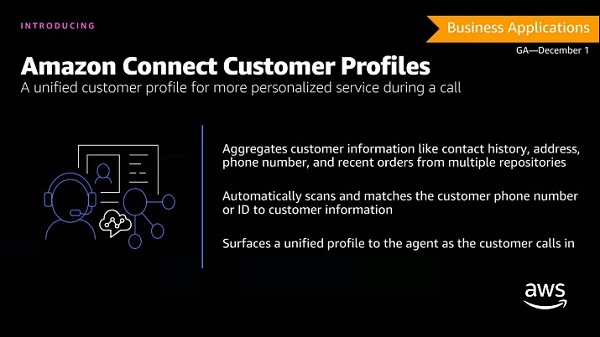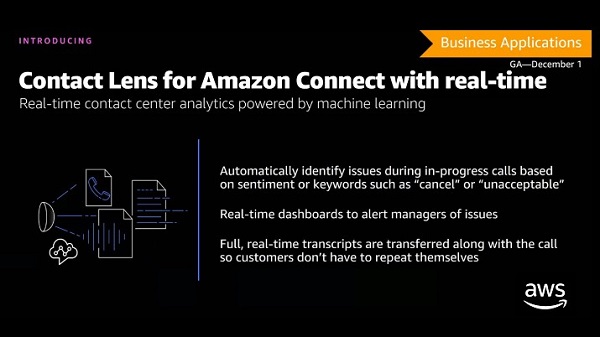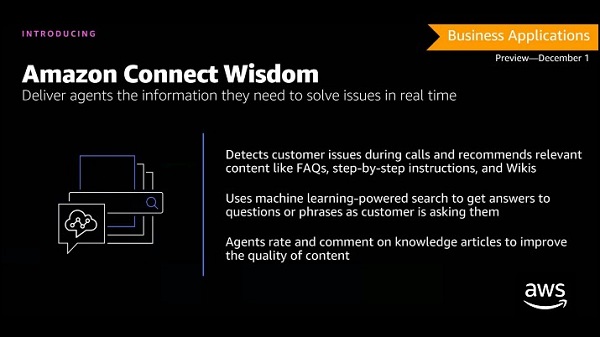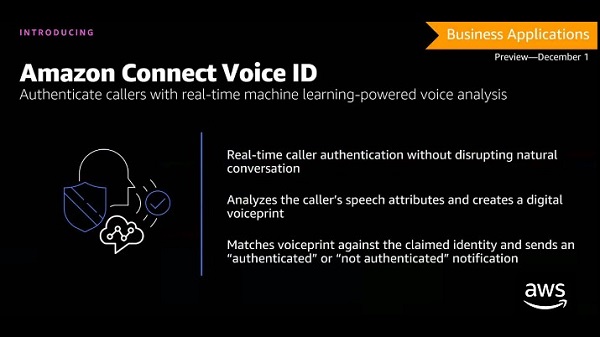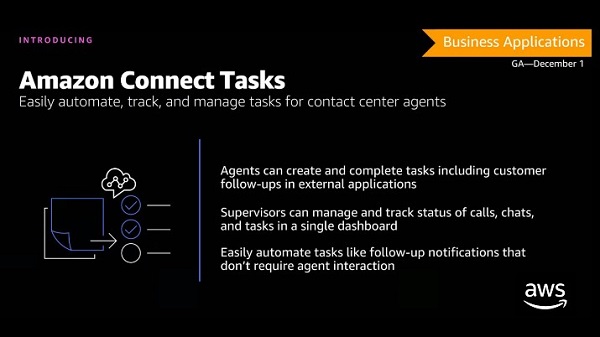Since its debut at Enterprise Connect 2017, AWS has released new functionality for its cloud contact center solution, Amazon Connect, with
regular cadence. Beginning in 2018, contact center market watchers (like me) have come to expect Amazon Connect news at the company’s annual conference, re:Invent. In 2019, the big news was an expansion from voice-only interaction routing to chat, a major announcement to integrate with Salesforce as the preferred Service Cloud Voice partner and Contact Lens for Amazon Connect, an analytics application powered by machine learning.
Similarly, the contact center news at
re:Invent 2020 does not disappoint. As shared with me in a pre-briefing on today’s announcements by Pasquale DeMaio, AWS general manager for Amazon Connect, AWS has introduced a unified customer profile, intelligence capability, voice ID, and task automation for its cloud contact center platform, as well as released real-time analytics updates for Contact Lens.
Amazon Connect Customer Profiles
While DeMaio did not lead my briefing with
Customer Profiles, for me this new functionality highlights AWS’s approach to delivering a differentiated contact center application.
As I listened to DeMaio’s description of the new unified customer profile service, described in the graphic below, I wondered why AWS isn’t calling Customer Profiles a customer data platform (CDP), since it certainly seems to have many of the attributes associated with a CDP. As I summarized in my October post on
Twilio’s acquisition of CDP leader Segment, CDPs “help companies collect all their customer data from every source, whether the website or mobile apps, helpdesks CRM, SMS, email ads, etc. … [then] take that collected customer data and activate it into downstream communication channels like email, SMS, ads, and so on.”
When I asked DeMaio, he told me: “I think [Customer Profiles] has CDP aspects, but I don't know that CDP is a well-defined thing out there today.” In naming the feature, he said, AWS “tried to be a little more explicit in what the value was to the [Amazon Connect] customer.”
That value is to collect and make available to the contact center all relevant information about a specific end customer, in one place, while they're using Amazon Connect, DeMaio said. That’s why AWS is not calling Customer Profiles a CDP or a CRM, but instead a tool that extends the value of Amazon Connect.
Next, I wondered this: If Amazon Connect Customer Profiles are assembled in real-time — e.g., if a customer calls or chats to a company — is something they did 20 minutes ago, perhaps online, reflected in the profile? The currency of the profile depends to some extent on the source of the data, but real-time is what the Amazon Connect team is working towards for all data sets, DeMaio said.
Amazon Connect Customer Profiles is generally available today but, according to DeMaio, will continue to improve with the addition of more connectors and plugins to applications and data sources, and with improved performance of them as well. In terms of pricing, Customer Profiles follows the Amazon Connect model of usage-based pricing, here based on the number of profiles stored.
Amazon Connect Wisdom
Note that while this section is about
Amazon Connect Wisdom, the accompanying graphics also describe real-time updates to the year-old
Contact Lens for Amazon Connect. Why? Because as DeMaio started his explanation of Wisdom, he immediately linked it to Contact Lens, comparing using both to a “peanut butter and chocolate kind of experience.”
Amazon Connect Wisdom is a combination of knowledge base-like capabilities with the ability to pull out relevant inferences from an on-going conversation — from the new real-time feature of Contact Lens — to enable delivery of information to agents that they need, right away. Previously, Contact Lens only provided analytics post-call, and now it offers real-time insights to agents and supervisors.
Companies can load their own content to Wisdom, and draw on that content from different locations within the organization. Information can be pulled from one or multiple knowledge bases and other sources of data. Wisdom then intelligently analyzes the information using machine learning to bring content to an agent. Content is delivered real-time, during a conversation, relevant to the customer issue or question. In addition, the agent can directly query Wisdom, and find applicable content or knowledge articles. This is done with natural language machine language search so the agent can type the question exactly as the customer asks it to find the right answer or relevant content. As part of continually tuning Wisdom, agents can provide feedback on the information Wisdom provided.
Amazon Connect Wisdom is available now in preview but, DeMaio said, “it's a working preview that companies can use to create in-production experiences.”
My first reaction is that Amazon Connect Wisdom bears a resemblance to
Google Contact Center AI Agent Assist. Functionally that may be true. A key difference is that Google operates as a third-party partner helping its contact center partners deliver Agent Assist. With Amazon Connect Wisdom, everything is available from a single vendor, in a pre-integrated fashion.
Amazon Connect Voice ID
As is true of the names for the other new Amazon Connect tools announced today, Voice ID is exactly what it sounds like — the use of voice biometrics to authenticate and identify customers. It uses passive enrollment, meaning a caller doesn’t have to say specific phrases in order to enroll.
AWS built Voice ID directly into Amazon Connect for use in authenticating customers, agents, and supervisors. With an increasing proportion of agents working from home, it offers companies an added level of security that the person hired and trained is answering the company’s calls or chats and not somebody else within the home.
With Voice ID, AWS is bringing voice authentication to market for the first time, exclusively as part of Amazon Connect. Note that voice authentication was, and continues to be, available from AWS Connect partners such as Auraya, NICE, and Nuance.
Amazon Connect Tasks
Last, but as is said, certainly not least, is
Amazon Connect Tasks, also generally available today. DeMaio described Tasks as applying what Amazon Connect does for voice and chat — e.g., intelligently route, queue, and report interactions — to “all the things that you would want to do to be able to make sure you're delivering a great outcome for your customers, not just voice calls and chats.”
What kind of “things” can you manage with Tasks? “Tasks range wildly from following up with an action that needs to be taken in a back-end system, to making sure agents ask customers the right questions, to being tracking or responding to a social media post,” DeMaio explained.
Each of the tools discussed here is designed to work specifically with Amazon Connect, DeMaio pointed out. The Amazon Connect team talks about building a solution, and adding capabilities to it that are so relevant and priced so reasonably that for any customer “it would be almost silly not to use these features and gain benefit from them. We want them to be a no-brainer to say yes to, an easy decision.”







